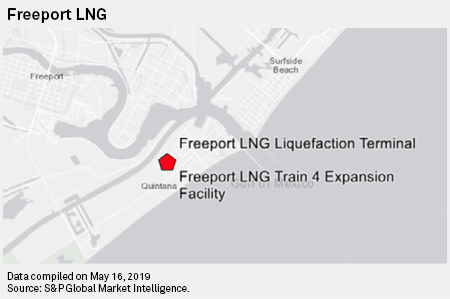Freeport LNG Development LP may sell excess LNG on a spot basis rather than through its traditional tolling model, the company's Chairman and CEO Michael Smith said in a Sept. 19 interview.
Freeport LNG would also consider alternative deal structures as it works to commercialize a project that would expand its LNG export terminal in Texas with a fourth natural gas liquefaction train, Smith told reporters from S&P Global Market Intelligence and S&P Global Platts as the annual Gastech conference wrapped up in Houston. Options would include sale and purchase agreements, or SPAs, similar to take-or-pay contracts that LNG pioneer Cheniere Energy Inc. used to commercialize its flagship Sabine Pass LNG terminal in Louisiana.
Smith praised recent Cheniere deals with Permian Basin producers Apache Corp. and EOG Resources Inc., and described the long-term commitments of the upstream companies as an important development for the broader U.S. LNG industry. He said Freeport LNG could enter similar agreements with gas producers for excess gas volumes.
"What Cheniere did with EOG and Apache is very constructive for the market, and I see more of that occurring," said Smith, who founded Freeport LNG. "There is a distinct possibility that something like that could occur at Freeport on an SPA, but we always have to know that we have a floor."
The model of Cheniere's recent gas agreements allows upstream developers to access a global price by selling their produced gas to world markets through Cheniere's terminal in Texas. In return for marketing the gas, Cheniere gets an undisclosed fee that covers liquefaction and other costs, while the upstream companies are exposed to the greater price risk.
But Freeport LNG does not plan to reserve capacity for the fourth train for spot volumes, Smith said. Instead, the priority when it comes to train 4 is securing offtake agreements that the company can use to secure financing for the project.
"Getting a contract that gives Freeport LNG unlimited upside but [includes] the downside that a bank will then not provide the financing does us no good, because train 4 won't get done," Smith said.
The executive declined to disclose the targeted capacity that Freeport LNG needs to reach before taking a final investment decision on the expansion, but he said "it's the vast majority of the capacity." Freeport has not contracted any of the capacity yet.
"We are working the customer side very hard," Smith said. "We are going to get it done sooner than later."

The first train of the original Freeport LNG project shipped the first commissioning cargo on Sept. 3, less than a month after becoming the sixth major U.S. LNG terminal to start up. Asked when he expects the first train to enter commercial service, Smith said he could not give an exact date.
"Soon," Smith said. "Really, we are so close to it. I can't really tell you this day versus that day, but we've loaded two cargoes, and we expect to be loading quite a few more before the actual commercial start begins."
The second and third trains are slated to start up in January and May, respectively. But Smith said he hopes the trains will start up sooner based on their progress so far.
The Freeport LNG terminal will be able to produce about 15.3 million tonnes per annum of LNG once the first three trains are in service. The fourth train is expected to add 5.1 mtpa of liquefaction capacity. Total long-term contracts cover roughly 13.2 mtpa of the three-train facility's output, with additional short-term contracts, including a three-year deal with commodity trader Trafigura, covering the remaining supply.
The facility, which is south of Houston along the Gulf of Mexico, experienced several construction- and weather-related delays, most notably after Hurricane Harvey in August 2017. But Smith said those are behind the project.
"It's actually going great," Smith said. "I couldn't say that for the last few years, obviously being delayed. But ever since we switched from trying to catch up on construction and just doing completion and startup, it's gone exceedingly well."
Harry Weber is a reporter with S&P Global Platts. S&P Global Market Intelligence and S&P Global Platts are owned by S&P Global Inc.



